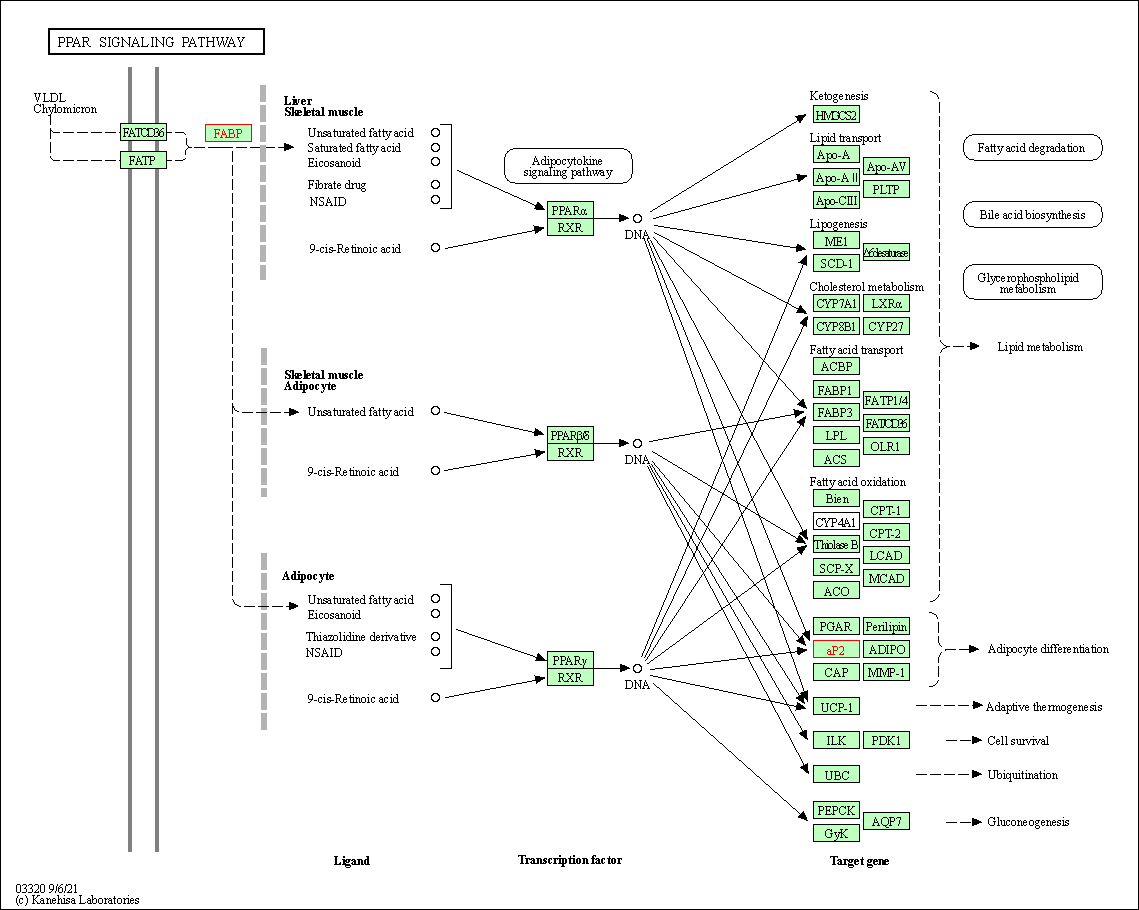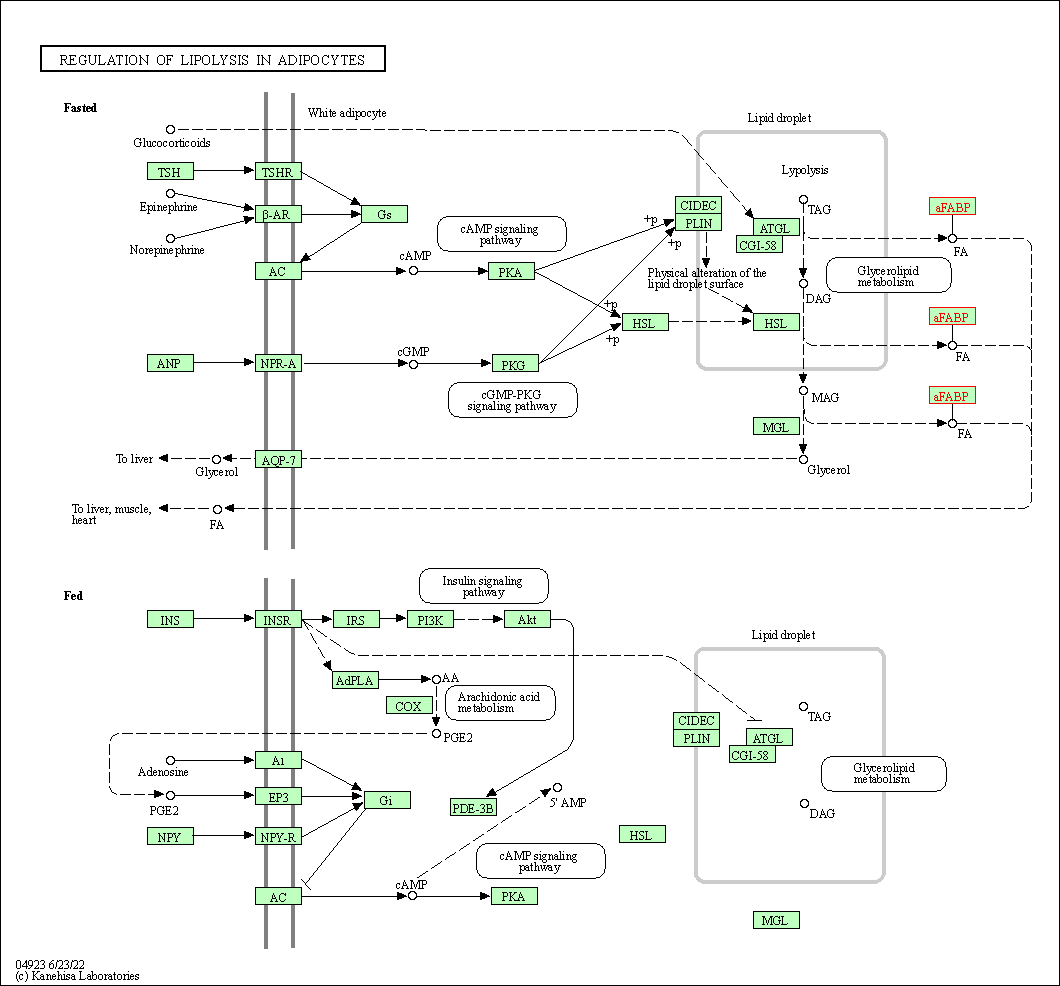Target Information
| Target General Information | Top | |||||
|---|---|---|---|---|---|---|
| Target ID |
T07217
(Former ID: TTDR00476)
|
|||||
| Target Name |
Fatty acid-binding protein 4 (FABP4)
|
|||||
| Synonyms |
Fatty acid-binding protein, adipocyte; Adipocyte-type fatty acid-binding protein; Adipocyte lipid-binding protein; Adipocyte fatty-acid-binding protein; Adipocyte fatty binding protein; ALBP; AFABP; A-FABP
Click to Show/Hide
|
|||||
| Gene Name |
FABP4
|
|||||
| Target Type |
Patented-recorded target
|
[1] | ||||
| Function |
Binds both long chain fatty acids and retinoic acid. Delivers long-chain fatty acids and retinoic acid to their cognate receptors in the nucleus. Lipid transport protein in adipocytes.
Click to Show/Hide
|
|||||
| BioChemical Class |
Fatty acid binding protein
|
|||||
| UniProt ID | ||||||
| Sequence |
MCDAFVGTWKLVSSENFDDYMKEVGVGFATRKVAGMAKPNMIISVNGDVITIKSESTFKN
TEISFILGQEFDEVTADDRKVKSTITLDGGVLVHVQKWDGKSTTIKRKREDDKLVVECVM KGVTSTRVYERA Click to Show/Hide
|
|||||
| 3D Structure | Click to Show 3D Structure of This Target | PDB | ||||
| HIT2.0 ID | T96G89 | |||||
| Cell-based Target Expression Variations | Top | |||||
|---|---|---|---|---|---|---|
| Cell-based Target Expression Variations | ||||||
| Drug Binding Sites of Target | Top | |||||
|---|---|---|---|---|---|---|
| Ligand Name: Ibuprofen | Ligand Info | |||||
| Structure Description | Human adipocyte lipid-binding protein FABP4 in complex with (S)-ibuprofen | PDB:3P6H | ||||
| Method | X-ray diffraction | Resolution | 1.15 Å | Mutation | No | [6] |
| PDB Sequence |
QQMGRGSMCD
2 AFVGTWKLVS12 SENFDDYMKE22 VGVGFATRKV32 AGMAKPNMII42 SVNGDVITIK 52 SESTFKNTEI62 SFILGQEFDE72 VTADDRKVKS82 TITLDGGVLV92 HVQKWDGKST 102 TIKRKREDDK112 LVVECVMKGV122 TSTRVYERA
|
|||||
|
|
||||||
| Ligand Name: BMS309403 | Ligand Info | |||||
| Structure Description | Crystal structure of human adipocyte fatty acid binding protein in complex with ((2'-(5-ethyl-3,4-diphenyl-1H-pyrazol-1-yl)-3-biphenylyl)oxy)acetic acid | PDB:2NNQ | ||||
| Method | X-ray diffraction | Resolution | 1.80 Å | Mutation | No | [7] |
| PDB Sequence |
CDAFVGTWKL
10 VSSENFDDYM20 KEVGVGFATR30 KVAGMAKPNM40 IISVNGDVIT50 IKSESTFKNT 60 EISFILGQEF70 DEVTADDRKV80 KSTITLDGGV90 LVHVQKWDGK100 STTIKRKRED 110 DKLVVECVMK120 GVTSTRVYER130 A
|
|||||
|
|
LEU10
4.761
PHE16
3.793
TYR19
4.617
MET20
4.005
VAL25
4.390
ALA33
3.135
ALA36
3.685
PRO38
3.609
ASN39
4.284
MET40
3.998
ILE51
3.632
LYS52
4.809
SER53
3.138
SER55
3.727
PHE57
3.821
|
|||||
| Click to View More Binding Site Information of This Target with Different Ligands | ||||||
| Different Human System Profiles of Target | Top |
|---|---|
|
Human Similarity Proteins
of target is determined by comparing the sequence similarity of all human proteins with the target based on BLAST. The similarity proteins for a target are defined as the proteins with E-value < 0.005 and outside the protein families of the target.
A target that has fewer human similarity proteins outside its family is commonly regarded to possess a greater capacity to avoid undesired interactions and thus increase the possibility of finding successful drugs
(Brief Bioinform, 21: 649-662, 2020).
Human Tissue Distribution
of target is determined from a proteomics study that quantified more than 12,000 genes across 32 normal human tissues. Tissue Specificity (TS) score was used to define the enrichment of target across tissues.
The distribution of targets among different tissues or organs need to be taken into consideration when assessing the target druggability, as it is generally accepted that the wider the target distribution, the greater the concern over potential adverse effects
(Nat Rev Drug Discov, 20: 64-81, 2021).
Human Pathway Affiliation
of target is determined by the life-essential pathways provided on KEGG database. The target-affiliated pathways were defined based on the following two criteria (a) the pathways of the studied target should be life-essential for both healthy individuals and patients, and (b) the studied target should occupy an upstream position in the pathways and therefore had the ability to regulate biological function.
Targets involved in a fewer pathways have greater likelihood to be successfully developed, while those associated with more human pathways increase the chance of undesirable interferences with other human processes
(Pharmacol Rev, 58: 259-279, 2006).
Biological Network Descriptors
of target is determined based on a human protein-protein interactions (PPI) network consisting of 9,309 proteins and 52,713 PPIs, which were with a high confidence score of ≥ 0.95 collected from STRING database.
The network properties of targets based on protein-protein interactions (PPIs) have been widely adopted for the assessment of target’s druggability. Proteins with high node degree tend to have a high impact on network function through multiple interactions, while proteins with high betweenness centrality are regarded to be central for communication in interaction networks and regulate the flow of signaling information
(Front Pharmacol, 9, 1245, 2018;
Curr Opin Struct Biol. 44:134-142, 2017).
Human Similarity Proteins
Human Tissue Distribution
Human Pathway Affiliation
Biological Network Descriptors
|
|
| Protein Name | Pfam ID | Percentage of Identity (%) | E value |
|---|---|---|---|
| Gastrotropin (FABP6) | 26.923 (35/130) | 8.80E-04 |
|
Note:
If a protein has TS (tissue specficity) scores at least in one tissue >= 2.5, this protein is called tissue-enriched (including tissue-enriched-but-not-specific and tissue-specific). In the plots, the vertical lines are at thresholds 2.5 and 4.
|


| KEGG Pathway | Pathway ID | Affiliated Target | Pathway Map |
|---|---|---|---|
| PPAR signaling pathway | hsa03320 | Affiliated Target |

|
| Class: Organismal Systems => Endocrine system | Pathway Hierarchy | ||
| Regulation of lipolysis in adipocytes | hsa04923 | Affiliated Target |

|
| Class: Organismal Systems => Endocrine system | Pathway Hierarchy | ||
| Degree | 5 | Degree centrality | 5.37E-04 | Betweenness centrality | 8.83E-04 |
|---|---|---|---|---|---|
| Closeness centrality | 2.22E-01 | Radiality | 1.39E+01 | Clustering coefficient | 3.00E-01 |
| Neighborhood connectivity | 3.94E+01 | Topological coefficient | 2.47E-01 | Eccentricity | 11 |
| Download | Click to Download the Full PPI Network of This Target | ||||
| Chemical Structure based Activity Landscape of Target | Top |
|---|---|
| Drug Property Profile of Target | Top | |
|---|---|---|
| (1) Molecular Weight (mw) based Drug Clustering | (2) Octanol/Water Partition Coefficient (xlogp) based Drug Clustering | |
|
|
||
| (3) Hydrogen Bond Donor Count (hbonddonor) based Drug Clustering | (4) Hydrogen Bond Acceptor Count (hbondacc) based Drug Clustering | |
|
|
||
| (5) Rotatable Bond Count (rotbonds) based Drug Clustering | (6) Topological Polar Surface Area (polararea) based Drug Clustering | |
|
|
||
| "RO5" indicates the cutoff set by lipinski's rule of five; "D123AB" colored in GREEN denotes the no violation of any cutoff in lipinski's rule of five; "D123AB" colored in PURPLE refers to the violation of only one cutoff in lipinski's rule of five; "D123AB" colored in BLACK represents the violation of more than one cutoffs in lipinski's rule of five | ||
| Target Poor or Non Binders | Top | |||||
|---|---|---|---|---|---|---|
| Target Poor or Non Binders | ||||||
| Target Regulators | Top | |||||
|---|---|---|---|---|---|---|
| Target-regulating microRNAs | ||||||
| Target Affiliated Biological Pathways | Top | |||||
|---|---|---|---|---|---|---|
| KEGG Pathway | [+] 1 KEGG Pathways | + | ||||
| 1 | PPAR signaling pathway | |||||
| NetPath Pathway | [+] 1 NetPath Pathways | + | ||||
| 1 | TCR Signaling Pathway | |||||
| PID Pathway | [+] 1 PID Pathways | + | ||||
| 1 | AP-1 transcription factor network | |||||
| Reactome | [+] 2 Reactome Pathways | + | ||||
| 1 | Hormone-sensitive lipase (HSL)-mediated triacylglycerol hydrolysis | |||||
| 2 | Transcriptional regulation of white adipocyte differentiation | |||||
| WikiPathways | [+] 2 WikiPathways | + | ||||
| 1 | Lipid digestion, mobilization, and transport | |||||
| 2 | Transcriptional Regulation of White Adipocyte Differentiation | |||||
| Target-Related Models and Studies | Top | |||||
|---|---|---|---|---|---|---|
| Target Validation | ||||||
| References | Top | |||||
|---|---|---|---|---|---|---|
| REF 1 | Fatty acid binding protein (FABP) inhibitors: a patent review (2012-2015).Expert Opin Ther Pat. 2016 Jul;26(7):767-76. | |||||
| REF 2 | N-Benzyl-indolo carboxylic acids: Design and synthesis of potent and selective adipocyte fatty-acid binding protein (A-FABP) inhibitors. Bioorg Med Chem Lett. 2009 Mar 15;19(6):1745-8. | |||||
| REF 3 | NMR structure of a potent small molecule inhibitor bound to human keratinocyte fatty acid-binding protein. J Med Chem. 2006 Aug 10;49(16):5013-7. | |||||
| REF 4 | Discovery of inhibitors of human adipocyte fatty acid-binding protein, a potential type 2 diabetes target. Bioorg Med Chem Lett. 2004 Sep 6;14(17):4445-8. | |||||
| REF 5 | Discovery of highly selective inhibitors of human fatty acid binding protein 4 (FABP4) by virtual screening. Bioorg Med Chem Lett. 2010 Jun 15;20(12):3675-9. | |||||
| REF 6 | Structural analysis of ibuprofen binding to human adipocyte fatty-acid binding protein (FABP4). Acta Crystallogr F Struct Biol Commun. 2015 Feb;71(Pt 2):163-70. | |||||
| REF 7 | Potent and selective biphenyl azole inhibitors of adipocyte fatty acid binding protein (aFABP). Bioorg Med Chem Lett. 2007 Jun 15;17(12):3511-5. | |||||
If You Find Any Error in Data or Bug in Web Service, Please Kindly Report It to Dr. Zhou and Dr. Zhang.

